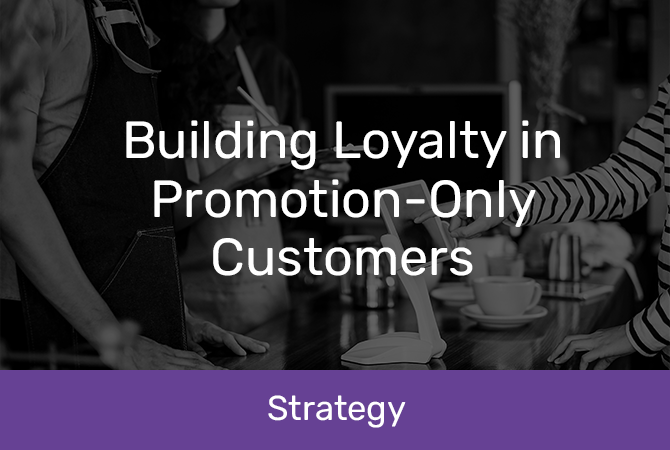
Building Loyalty In Promotion-Only Customers
data can help turn casual customers into long-term fans
Your promotions deliver sales, but do they deliver long-term value?
While promos can be powerful, they often offer a false sense of success. Many customers who buy during the sale season are only there for the red sticker price – in other words, they won’t stick around once the promotion is over.
Imagine you’re leading a marketing team for a footwear retailer. You have a customer base of roughly a million people, with 200,000 loyal customers who buy your shoes no matter what. The other 80% might buy when you have a big sale, but they have no qualms about shopping elsewhere if a better price pops up. While that’s a pretty standard split for retail, if you can shift even a small percentage of customers over to the loyal side of the ledger, it can translate to a significant revenue boost.
So, how do you move the needle on that 80/20 split and turn fickle, promo-driven shoppers into die-hard fans? It comes down to data.
 create engaging customer experiences
create engaging customer experiences
The customer experience isn’t just about the touchpoints leading up to a sale – it’s about every interaction with your business. That includes ad content and your website, talking with sales reps or chatbots, emails and communication after a purchase. Creating rich, engaging and consistent experiences can be a powerful way to boost engagement and drive loyalty. Essentially, you want customers to come away from a purchase with positive feelings about your business so that it will overshadow a cheaper price from a competitor.
Data can help you refine the customer experience and identify any gaps. For example, you might notice a high bounce rate – meaning customers click away quickly after coming through to your website. This could mean your site is slow to load, doesn’t look appealing to customers, or isn’t easy to navigate. Changing that part of the experience could help pull more customers through to the conversion stage.
FOCUS your energy on potential value
It would be wonderful if you could turn every sales shopper into a loyal buyer, but in reality, there’s no way to win everyone over. Instead, use data to identify customers most likely to return, and focus your energies – and promo efforts – on them.
Identifying that potential value can involve a bit of digital sleuthing – combing through historical data to spot trends and purchasing patterns. For example, you could find a correlation between purchasing multiple items during a sale and repeat purchases at non-sales times. Or, you might see that new customers who only buy heavily discounted items are less likely to become repeat customers.
If you can identify those data points, you can start to segment new customers as they come in and focus your most intensive targeting on those most likely to deliver value. Think customers with high potential value receiving expedited shipping or a personalised follow-up email from your sales team.
nurture and nudge
Most businesses have some kind of automated email sequence set up for new customers, with welcome messages, discount codes and more. But all nurture journeys are not created equal, and it’s easy to get wrong. Building lasting relationships and boosting loyalty takes time and a delicate touch – a barrage of sales-heavy emails from a business will turn most potential customers off.
Instead, focus your nurture journey on engagement and brand messaging. Personalise emails with the customer’s name and other details if you have them, and make it clear that you value them as a customer. If it makes sense, educate them about your product benefits and brand background without explicitly pushing a sale. The goal is to stay top-of-mind without crossing over into annoying territory.
 reward repeat customers
reward repeat customers
Everyone loves a good reward – in fact, research shows that 79% of customers are more likely to do business with brands that have good rewards programs. Loyalty programs can be especially enticing for promotion-driven customers, as points and exclusive discounts can help them feel that they’re getting a great deal even if they’re buying outside of a sale period. So one of the first steps in your nurture journey should be an email or text message prompting the customer to sign up for your scheme.
Of course, rewards programs must be thoughtfully designed to help them stand out from the crowd – you don’t want to be one of 12 unused cards cluttering your customer’s wallet. If you want them to remember and engage with your program, you need to make rewards easy, meaningful and achievable.
Easy: give customers engagement options – for example, instead of a physical card, an app that’s easy to view and redeem points.
Meaningful: most customers won’t go out of their way for a 5% discount, so make rewards as significant as possible without eating into profitability. It’s also about perception – while a 5% reward might add up to more savings over time, a one-off $20 voucher can feel like a better ‘prize’.
Achievable: if customers see rewards as far out of reach, there’s little point in using the scheme. Consider offering a discount or freebie after, say, $100 worth of purchases instead of $1000.
Data analytics can help you determine how customers are using – or not using – your current loyalty program and how to tweak and adjust it to maximise engagement.
 stand out from the E-COMMERCE crowd
stand out from the E-COMMERCE crowd
Many retailers use a cookie-cutter approach to customer outreach and engagement, making it difficult for newer customers to differentiate between brands. Going the extra mile with service and customer experience creates an opportunity to stand out and boost that all-important loyalty. A survey from Salesforce backs this up, with 81% of customers saying they are more likely to shop from a business again if they receive ‘good’ customer service the first time.
This could be a personalised email or text thanking new customers for their business, a hand-written note in their first package, a tiny treat or freebie or a follow-up to ask about the product a few days after a purchase. You could also consider expediting shipping for new customers, so their product comes faster than expected. Online shopping generally lacks human interaction, so small moments of kindness or care will stand out.
share your expertise
If every communication from your business focuses on sales, it’s easy for customers to switch off and ignore it. That’s why sharing other information like brand stories, product information, case studies, and industry news is important. This approach can help position your brand as a leader in your sector and give customers more positive interactions with your business. According to Forbes, this kind of brand expertise can be even more valuable than customer reviews.
How do you promote your know-how? Use email marketing to share updates and advice, add sections to your website to recommend specific products and consider including a blog or article section to share relevant or interesting content. For example, if your business sells candle-making supplies, have instructions, ideas and troubleshooting information on your site.
Once you have thought leadership content in place, you can use data to track its impact and adjust your approach. Are customers engaging with instructional videos or blog content more often? Do case studies correlate with increased conversions or contact?
try a subscription strategy
Different sales approaches can make all the difference for customers looking for a bargain. If your data shows that certain customers are buying a specific product regularly, reach out and offer them an automatic repeat order, complete with a discount or bonus offer. Of course, this approach generally only works for consumable products. For example, if you sell hair care products, customers will likely need a new bottle every 2-3 months. If you sell kitchen knives, not so much.
For new customers, offering this kind of repeat sales service could be the difference between a one-off sale and a long-term customer.
ask for feedback
Creating great customer experiences is much easier if you know what your customers want. Some customers don’t care about loyalty programs, while others live and die by rewards points. Some appreciate discount codes and sales – this is where your promo customers come in – while others are more concerned about quality. Some are upset by minor issues with orders or shipping – others couldn’t care less.
To work out what matters to your customers, ask them! When new customers make their first purchase, send a survey to ask about their experience with your business and your product, or email them to ask whether they have questions or concerns, or need help with the product. You won’t get a reply from every customer, but the information you get is a valuable tool that can help improve the customer experience and keep customers coming back. Asking new customers for feedback can also be a point in your favour – it makes them feel your business cares about their needs and wants.
get social
Social media’s casual, friendly nature makes it the perfect way to connect with new customers. It’s a way to stay top-of-mind without bombarding them with emails.
If customers purchase a product through a social platform, you can use that platform to reach out post-purchase. For example, if you can see that a customer has bought through Instagram, you can send them a survey or a follow-up message, or use retargeting ads through the platform. You can also encourage customers to tag your business in their stories or tweets – there’s nothing like some free exposure from a happy customer.
personalise, personalise, personalise
The power of personalisation is undisputed, with 80% of consumers saying they are more likely to buy from a brand that offers personalised experiences. Personalisation can be even more important for those one-off, promo-driven, casual customers – a way to build connections and pull people into your brand experience.
Personalisation can be as simple as using a customer’s name in an email or text or sending a birthday discount code, or as complex as tracking browsing patterns and making recommendations based on that behaviour. Both approaches rely on real-time data and tech to help you personalise at scale.
be smart about future promos
Even if you’re focusing on customer loyalty and retention, it doesn’t mean you need to ditch promotions and sales altogether. Instead, make them timely and meaningful – and don’t overdo it. Use historical data to track sales trends across the year and use that information to time your major promotional events. For example, if you get a big sales spike around Black Friday at the beginning of the Christmas shopping season, it’s worth running a sale at that time – and make it count. If there’s a slump in January, that could also be an excellent time to offer a discount or other incentive. You can also consider targeting different segments with different offers at different times. For example, if you sell stationery, you could run a ‘back to school’ promo aimed at students and their parents. Exclusive ‘members only’ sales events can also be a big drawcard for new, not-quite-loyal customers.
The key is getting the right offer in front of the right person at the right time – not blasting everyone on your list with weekly sales events.
 the discount-to-devotion pipeline
the discount-to-devotion pipeline
Every business wants a customer base full of loyal customers – but most don’t put in the work to make it happen. So if your customer base is heavy on discount shoppers and light on loyalty, it’s worth changing your marketing strategy.
Well-designed loyalty programs, great customer service, nurture journeys, customer experiences and personalised communication all add up to a brand that stands out and customers who feel noticed and cared for. And, in today’s uber-competitive retail landscape, that can make a huge difference to your retention rates. When a 5% increase in retention can lead to a 125% boost in profitability(!), putting your energy into loyalty makes sense.
If you need help identifying those high-value customers, sorting out your customer experience or finding ways to connect with new customers, Datamine can help. We work with clients across Australia and New Zealand in almost every sector – from retail and banking to not-for-profits.
Get in touch to chat with our team.















































